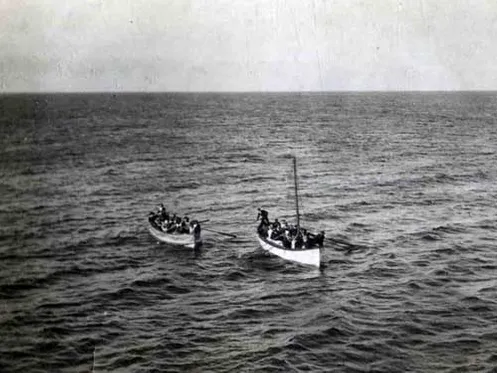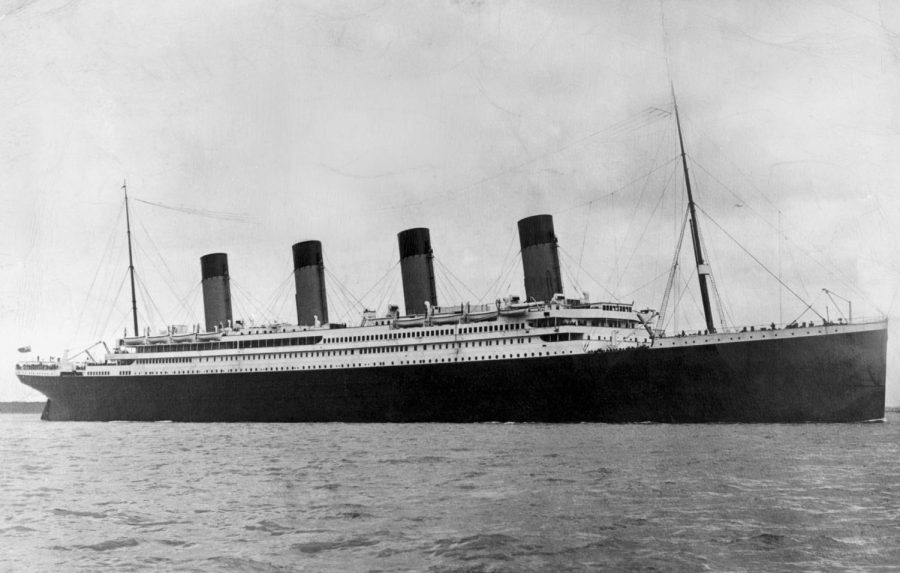The Unsinkable Ship
This coming April 15 will mark the 110-year anniversary of the Titanic’s sinking, serving as a day to commemorate the lives lost during the tragedy.
On April 15, 1912, the RMS Titanic, prized possession of the White Star Line ship company, struck an iceberg 325 miles off the coast of Newfoundland, and 1,300 miles from its destination of New York City. After two hours and forty minutes of panic and strife, the ship slipped beneath the icy waves of the Atlantic Ocean and sank to the sea floor.
The RMS Titanic was the second of three new luxury cruise liners commissioned for construction by the White Star Line. The White Star Line was a British shipping company, and in its day was the leading company in ship construction and technology.
At the time of its construction, the RMS Titanic was the biggest man-made moving object built in the world. The Titanic was approximately 882 feet long, 92 feet wide, and 175 feet tall, about the size of a 17-story building. The Titanic was made up of 10 decks, the extra seven stories to its height was added by its four massive smoke funnels, each of which were 62 feet in height.
The RMS Titanic was dubbed “The Unsinkable Ship” by its builders and designers. The ship possessed 16 individual watertight compartments. Each compartment was equipped with electric watertight doors that could be operated individually or simultaneously by a switch on the bridge.
Titanic’s captain Edward John Smith remarked to a reporter representing the Washington Times in Ireland, that “Even god himself couldn’t sink this ship.” According to the ship’s designer, Thomas Andrews, the ship could stay afloat even if four of its 16 compartments were fully flooded. As fate would have it, at least five compartments were breached, and the sixth was damaged.
Due to this overwhelming sense of confidence and faith, the ship was fitted with 16 lifeboats, as well as four “collapsibles” which were lifeboats fitted to the roof of the top deck, which could be taken down and lowered as a normal lifeboat. The 20 lifeboats were only enough to hold about one third of the people that were on the ship at the time of the sinking. At the time, legally, the Titanic had over the number of required lifeboats.

The Titanic could have carried up to 64 lifeboats in total, however designers decided to have 20, believing that 64 would make the top decks far too crowded, and would limit the view of the passengers.
Departing on April 10, Titanic set off on its week-long voyage from Southampton, England, to New York City. The ship was designed to be a luxury cruise liner, fitted with the newest technology of the time and the most lavish amenities. This included a gym, pool area, and smoking rooms. They were also provided with gourmet meals served by the ship’s top chefs, though meal quality and type did depend on the class you were in.
The Titanic had enough space to accommodate over 2,435 passengers and 900 crew, bringing the ships total population capacity to over 3,300 people. At the time of the ships sinking, over 2,200 people were aboard. Of the 2,240 people on board the ship, only 706 people were sent off in lifeboats and rescued by the RMS Carpathia, the ship that responded to the doomed ships distress calls and arrived over 3 hours after the ship had sunk. In total, more than 1,500 people had lost their lives in the tragedy.
In an interview with BBC in 1990, Eva Hart, a survivor of the Titanic who was 7 years old at the time, told of her experience.
“As for the lifeboats, well they weren’t launched very quickly. At first no one thought anything was going to happen, the ship was supposedly unsinkable after all. The lifeboat I was put in with my mother had only about 20 people in it, and it could carry up to 60.”
Due to the distinct lack of concern among the passengers aboard the doomed ship, the first lifeboats launched were not at full capacity, and carried only a fraction of the people they could have saved.
Hart continues, “My father went to talk to an officer who was on the boat deck at the time. He told him that they were going to launch two lifeboats for now, but you know, we’ll all be back for breakfast. Of course, this never came to fruition”
After the sinking, the White Star Line conducted an investigation and determined that if the first lifeboats launched were at full capacity, an additional 450 people could have been saved, bringing the survivor count from the 706 that did, to slightly over 1,100.
In response to the sinking, and subsequent legal fallout, in 1914, a group of representatives from 118 different countries came together and formed SOLAS (The International Convention for the Safety of Life at Sea) and created a document consisting of 14 different sections, creating various revisions and new laws for ocean travel. Among these revisions was the law that required any and all passenger vessels to hold enough lifeboats for more than enough of the people that could be aboard the ship at any given time.
The true importance of this law was shown to the world on November 21, 1916. During the height of the first world war the Hospital ship, and sister ship of the RMS Titanic, HMHS Britannic, struck a sea mine while sailing through the Aegean Sea, and sank in less than 55 minutes. Luckily at the time, the ship was sparsely populated, carrying 1,066 people, after having just dropped off hundreds of wounded soldiers to allied ports. Due to the new provisions however, only 30 lives were lost in the sinking.
Every year on April 15, the United States Coast Guard drops a wreath over the location of the shipwreck to honor the lives lost. It’s a continuation of the ship’s memory and historical significance.
Your donation will support the student journalists of Foran High School. Your contribution will allow us to purchase equipment and cover our annual website hosting costs.

Hi, my name is Thomas Gauthier and I am a junior at Foran High School. I enjoy drawing, swimming, playing video games, and I do fencing outside...







